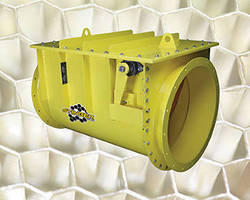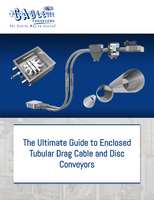Isolation Valve protects against dust collector explosions.
Press Release Summary:

Explosion tested and certified to NFPA standards, Stinger™ isolates dust collector explosions to prevent deflagration from traveling back through inlet pipe into workspace. Product can retrofit onto most dust collection systems and be used with new or existing Farr Gold Series® dust collectors where risk of combustible dust explosion exists. Composite blade reacts with maximum speed if explosion occurs, and construction minimizes pressure drop needed to hold blade open during normal flow.
Original Press Release:
New Stinger(TM) Explosion Isolation Valve Protects against Dust Collector Explosions
Explosion Tested and Certified to Comply with NFPA Standards
The Stinger™ explosion isolation valve prevents a dust collector explosion from traveling back through the inlet pipe into the workspace.
Jonesboro, Ark. — Camfil Air Pollution Control has introduced the Stinger™, an explosion isolation valve that isolates dust collector explosions to prevent a deflagration from traveling back through the inlet pipe of the dust collector into the workspace. Following extensive testing, Camfil APC reports that the Stinger is the first U.S.-made explosion flap valve to be certified by an independent testing agency to comply with NFPA standards. It may be retrofitted onto most dust collection systems and used with new or existing Farr Gold Series® dust collectors where the risk of a combustible dust explosion exists.
explosion test
The Stinger™ valve has been explosion tested and certified to comply with NFPA standards.
A key feature of the Stinger valve is a lightweight, patent-pending composite blade that reacts with the highest possible speed in the event of an explosion. It closes faster than heavier steel blades typically used for dust collector inlet protection. Because of its light weight, less pressure drop is needed to hold the blade open during normal flow, saving on energy use. Also, the composite material has a smooth surface and does not use stiffeners which can allow dust to build up on the blade to compromise performance.
During normal operation, the airflow holds the blade open. If a deflagration occurs in the dust collector, a pressure wave will travel through the pipe faster than the flame front and close the flap valve, protecting downstream personnel and equipment from injury and damage. When the valve is fully closed, a latching mechanism keeps it shut. The closed valve prevents the transmission of flame and keeps smoke, dust and burning debris from traveling through the inlet pipe into the factory. The blade is easily replaceable, eliminating the need to replace the entire valve after an explosion event. A wear-resistant liner that also functions as a wear indicator will show when the blade needs to be replaced.
For product information and a video on the Stinger explosion valve, go to www.camfilapc.com/stinger. For general information, contact Camfil APC at 800-479-6801 (U.S./Canada) or 1-870-933-8048 (international); email filterman@camfil.com, web www.camfilapc.com.




